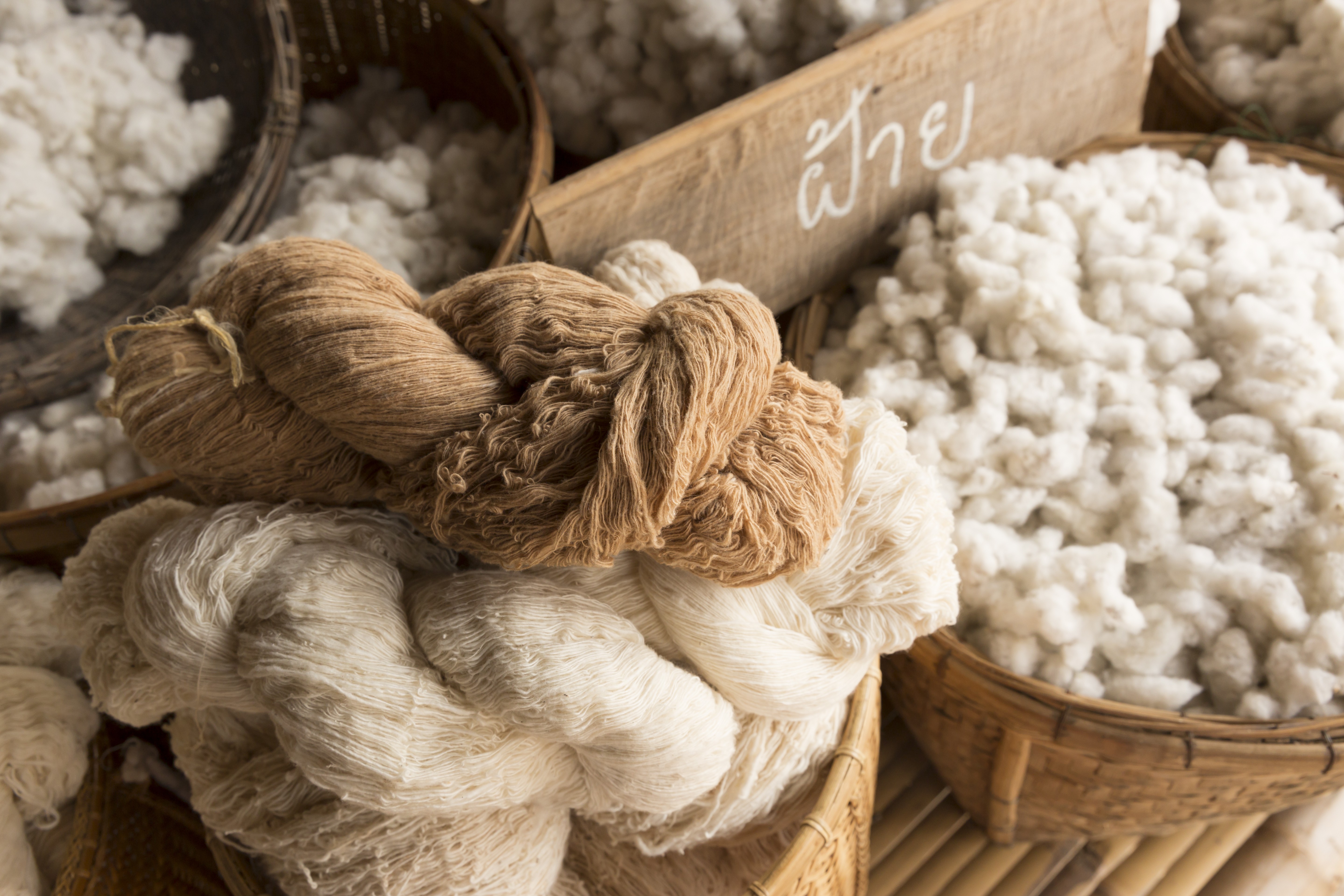In-home textiles today, the market for natural, environment-friendly, and health-aware products is expanding quickly. However, most consumers are confused by the labeling—what does it mean by linen, ramie textile, or polyester? Are these textile materials eco-friendly? And what is it about natural fibers that are different from synthetic fibers? This blog will demystify the "myth in the textile world" by comparing natural and synthetic textiles and exploring their everyday applications in common household items, such as bath mats, bedding, and curtains. Beyond just materials, we'll explore how these choices impact comfort, durability, and sustainability in your living space.
Natural vs. Synthetic Textiles: Key Differences
Natural fibers are sourced directly from nature and can be broadly categorized into three types based on their sources of origin: plant-based, animal-based, and mineral-based fibers. Plant-based fibers such as cotton, flax (linen), jute, and ramie are primarily made of cellulose, a natural polymer found in plant cell walls. Animal-based fibers include wool, silk, and alpaca, which are composed mainly of proteins like keratin and fibroin. Mineral fibers, like asbestos, are naturally occurring inorganic fibers, though they are less commonly used in modern textiles.
On the other hand, synthetic textiles (or fibers) are manufactured from petrochemical sources and have been praised and critiqued for their environmental impact. Unlike many natural fibers, synthetic fabrics are engineered for durability—they resist shrinking, stretching, and fading, maintaining their shape and appearance over time. The long durability characteristics of products, to some extent, can contribute to the sustainability goal by extending the product's lifespan and reducing the need for frequent replacement. However, synthetic fibers are generally non-biodegradable and may potentially contribute to microplastic pollution if not properly managed. To alleviate these concerns, responsible production and disposal methods are essential on the production side.
However, there are several significant benefits to using natural fibers for home textiles, such as curtains, bedding, and bath mats. Due to their exceptional breathability, which allows moisture and air to flow freely, they help regulate temperature and reduce the likelihood of mold or mildew growth. Many natural fibers are also durable and retain their quality even after regular washing. They are a comfortable option for those with allergies or sensitive skin due to their hypoallergenic properties. However, during cultivation, natural fibers may occasionally require more resources, such as water and pesticides. If not correctly cared for, they might be prone to shrinking or wrinkling.
Top Natural Textile Materials for Home Decor
Here are some great options to think about if you want to use natural textile materials in your home decor; each has special qualities that make it suitable for a variety of applications:
- Cotton: Known for its softness and breathability, cotton is a great material for bed linens and bath towels. Its cozy and refreshing texture makes it ideal for daily use.
- Linen: For tablecloths and curtains, linen is an excellent option due to its durability and ability to wick away moisture. Its natural texture adds a refined, rustic charm while withstanding normal wear.
- Wool: Wool is a fantastic natural insulator, perfect for blankets and rugs, as it not only offers outstanding warmth but also long-lasting durability. Any living area can be transformed into a warm and welcoming haven thanks to its exceptional ability to retain heat while letting air flow.
- Bamboo Fiber: Because of the natural antimicrobial qualities of Bamboo fiber and sustainability, it has been shown during the production process that bamboo textiles are highly prized. They provide an excellent option for bath mats and towels by combining environmental responsibility with hygiene, offering both eco-friendly comfort and cleanliness to end consumers.
- Jute and Hemp: These fibers are well-liked for woven rugs and storage baskets because of their strength and environmental friendliness. Their robust texture encourages sustainable living habits while improving durability and adding an organic, earthy charm to your house.
- Silk: Silk is the ideal material for upscale bedding and decorative pillows due to its opulent sheen and smooth texture. When used as a home textile, it retains the rich texture and inherent beauty of a high-end fabric, adding a chic and elegant touch to any area.
Eco-Friendly Textile Manufacturing: What to Look For
Understanding the entire range of ethical and sustainable manufacturing is essential when selecting eco-friendly textiles. Actual ethical textile production extends beyond the use of natural fibers. On the production side, it involves reducing carbon emissions, removing hazardous chemicals from the supply chain and end products, and implementing fair labor practices for workers. This pledge ensures that producers employ ecologically friendly practices that minimize pollution and conserve resources, or recycle waste. Under the principle of providing eco-friendly textile manufacturing, manufacturers do make fair compensation and secure working conditions.
To ensure these standards are met, look for recognized certifications that verify a product's environmental and social credentials. The Global Organic Textile Standard (GOTS) is one of the most comprehensive certifications, covering the entire supply chain from organic fiber harvesting to manufacturing and labeling. GOTS-certified products must contain at least 70% organic fibers and adhere to strict environmental and social criteria, including banning toxic chemicals and prohibiting exploitative labor practices.
Another necessary certification is OEKO-TEX Standard 100, which focuses on consumer safety by testing textiles for harmful substances. Products bearing this label guarantee that they are free from chemicals that could harm human health. Additionally, the "Fair Trade" certification ensures fair wages and ethical working conditions for producers. In addition to environmental concerns, this certification promotes social sustainability.
How can one determine which home textile brands are environmentally friendly? The first step is to look for these certifications on company websites and product labels. Openly disclosing their sourcing and manufacturing processes, transparent brands often participate in third-party audits. Seek out unambiguous information regarding the production processes, materials utilized, and social responsibility programs. Steer clear of ambiguous claims like "natural" or "green" without certification, as these can be deceptive.
By prioritizing certified products and ethical brands, consumers can support a textile industry that values the planet and the people behind the products, making sustainable choices that truly make a difference.
Leading Eco-Friendly Textile Manufacturing Companies
Suppose you're searching for a trusted company to supply high-quality textile products such as bath mats and rugs, or any other home textile products. Partnering with manufacturers who prioritize sustainability, quality, and transparency is essential. Here are some listed options of top textile manufacturers and tips to guide your selection.
Zhejiang Broadway Textile: A Pro in Sustainable Textiles Manufacturing Zhejiang Broadway Textile stands out as a premier bath mat manufacturer and eco-friendly textile manufacturer. Since 2011, the company has combined innovation with social responsibility to produce a range of home textiles, including travel pillows, bath mats, and other products. They have established enduring relationships with well-known international brands like Costco and IKEA, thanks to their dedication to environmentally friendly materials and sustainable production methods. Zhejiang Broadway Textile is a global example of how producers can strike a balance between sustainability, quality, and moral business conduct.
Other Notable Sustainable Textile Brands: These include prominent businesses such as Eileen Fisher, Patagonia, and Lenzing, which have established high standards for the production of sustainable textiles. These companies are dependable collaborators or sources of inspiration for companies seeking to produce eco-friendly textiles, as they prioritize fair labor practices, organic materials, and reduced environmental impact.
How to Choose the Right Textile Manufacturer When selecting a textile manufacturing partner, always prioritize companies with traceable supply chains and transparent sourcing. Working with manufacturers audited by large corporations like Costco or IKEA can provide added assurance of quality and compliance for startups or smaller businesses. These audits make sure the manufacturer complies with stringent social and environmental responsibility requirements.
For instance, Zhejiang Broadway Textile is a smart option for companies aiming to expand sustainably because of its track record of supplying to big-box retailers and upholding strict quality standards.
Interested in Our Sustainable Textile Solutions?
Contact us now to discover how partnering with a reliable, eco-friendly textile manufacturer can elevate your product line and support a greener future.


 EN
EN
 AR
AR
 BG
BG
 HR
HR
 CS
CS
 DA
DA
 NL
NL
 FI
FI
 FR
FR
 DE
DE
 EL
EL
 HI
HI
 IT
IT
 JA
JA
 KO
KO
 NO
NO
 PL
PL
 PT
PT
 RO
RO
 RU
RU
 ES
ES
 SV
SV
 TL
TL
 ID
ID
 LV
LV
 SR
SR
 SK
SK
 SL
SL
 UK
UK
 VI
VI
 HU
HU
 MT
MT
 TH
TH
 TR
TR
 FA
FA
 MS
MS
 GA
GA
 IS
IS
 KK
KK
 UZ
UZ
